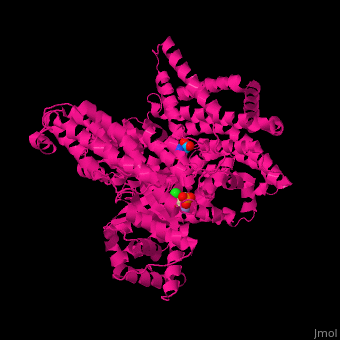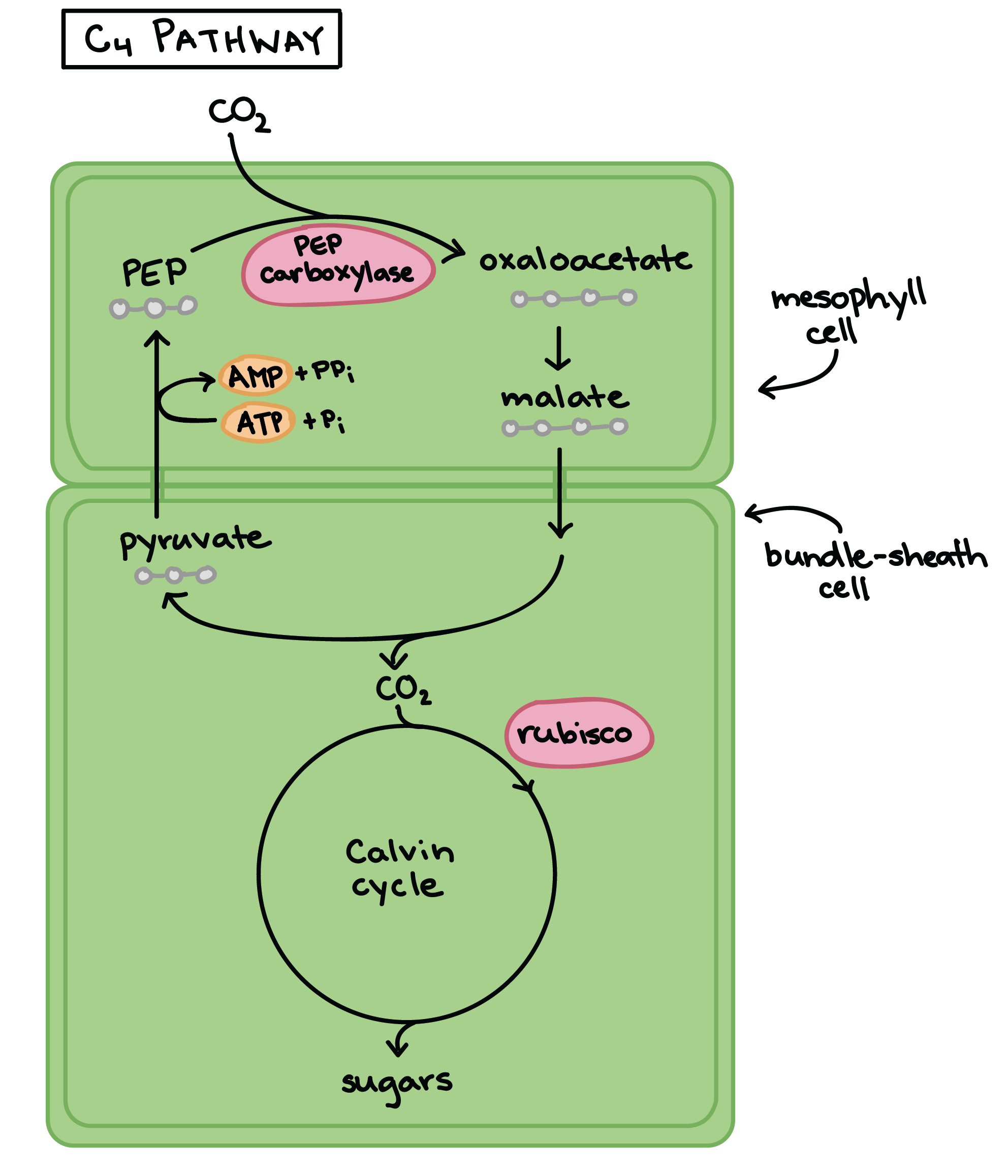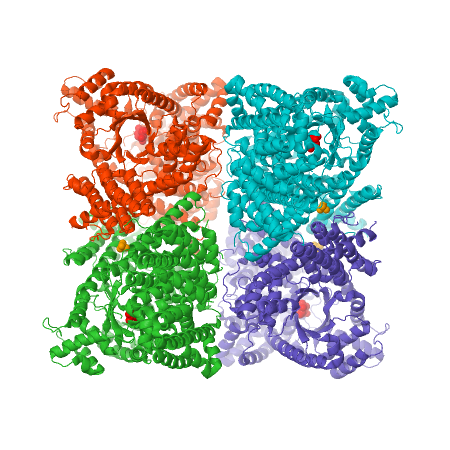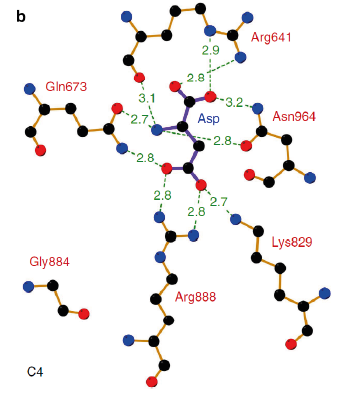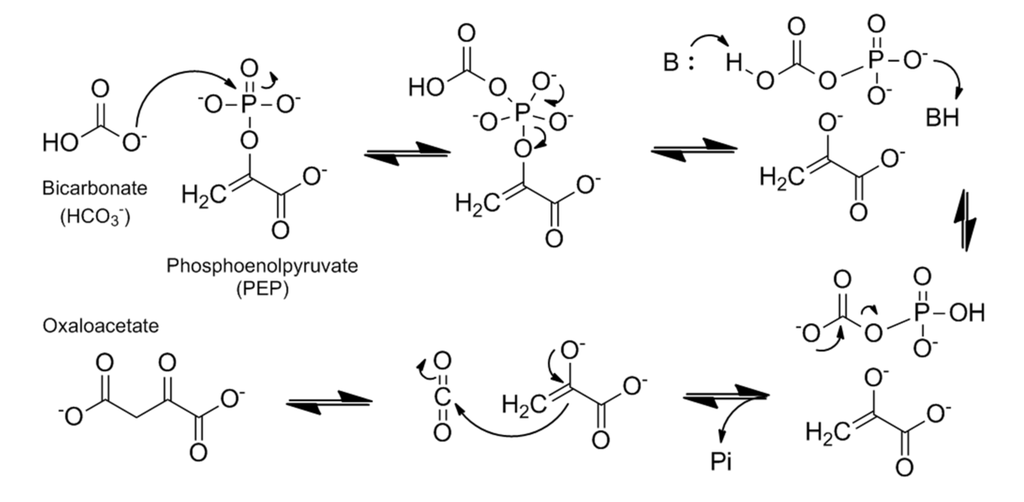Phosphoenolpyruvate carboxylase
From Proteopedia
(Difference between revisions)
| Line 3: | Line 3: | ||
== Function == | == Function == | ||
| - | '''Phosphoenolpyruvate carboxylase''' (PEPC) catalyzes the irreversible β-carboxylation of PEP in the presence of HCO3- to yield OAA (oxaloacetate) and Pi ( inorganic phosphate), using Mg2 + as a cofactor <ref name="O'Leary2011">PMID: 21524275</ref>. It is a key element in | + | '''Phosphoenolpyruvate carboxylase''' (PEPC) catalyzes the irreversible β-carboxylation of PEP in the presence of HCO3- to yield OAA (oxaloacetate) and Pi ( inorganic phosphate), using Mg2 + as a cofactor <ref name="O'Leary2011">PMID: 21524275</ref>. It is a key element in [https://en.wikipedia.org/wiki/C4_carbon_fixation C4 carbon fixation] <ref name="sage2004">PMID: 33873498</ref>. |
[[Image:C4_PEPC_reaction_and_regulation.png|center|frame|caption position=bottom|'''Figure 1''' Schematic representation of PEPC catalysis of phosphoenolpyruvate carboxylation. Adapted from Svensson et al. 2003. <ref name="svensson2003"/>]] | [[Image:C4_PEPC_reaction_and_regulation.png|center|frame|caption position=bottom|'''Figure 1''' Schematic representation of PEPC catalysis of phosphoenolpyruvate carboxylation. Adapted from Svensson et al. 2003. <ref name="svensson2003"/>]] | ||
| Line 11: | Line 11: | ||
== Overview == | == Overview == | ||
| - | The enzyme phosphoenolpyruvate carboxylase (PEPC) catalyzes the carboxylation of phosphoenolpyruvate to form oxaloacetate, with Mg2+ or Mn2+ as essential cofactors <ref name="kai2003">PMID: 12781768</ref><ref name="svensson2003">PMID: 12781769</ref>. It can be considered the key enzyme in the C4 photosynthesis process, once it’s a central part of the mechanism that makes C4 plants more efficient in carbon fixation compared to classical C3-photosynthetic pathway plants, especially in abiotic stress environments <ref name="sage2012">PMID: 22404472</ref>. PEPC is a ubiquitous enzyme, present in the genome of all plants. However, the isoforms found in C4 metabolism plants differ in their kinetic and regulatory characteristics, when compared to C3 orthologs <ref name="Paulus2013">PMID: 23443546</ref>. Among the Flaverina genus of the Asteraceae family, closely related C3 and C4 species are found, providing a good model to study the differences between the two processes. The comparative analysis of ''Flaverina pringlei'' (C3) and ''Flaverina trinervia'' (C4) PEPC’s, has shown that the exchange of single amino acids can be responsible for the observed differences in saturation kinetics and inhibitor tolerance between PEPC’s of C3 and C4 species <ref name="blasing2000">PMID: 10871630</ref><ref name="Paulus2013"/>. | + | The enzyme phosphoenolpyruvate carboxylase (PEPC) catalyzes the carboxylation of phosphoenolpyruvate to form oxaloacetate, with Mg2+ or Mn2+ as essential cofactors <ref name="kai2003">PMID: 12781768</ref><ref name="svensson2003">PMID: 12781769</ref>. It can be considered the key enzyme in the [https://en.wikipedia.org/wiki/C4_carbon_fixation C4 photosynthesis] process, once it’s a central part of the mechanism that makes C4 plants more efficient in carbon fixation compared to classical C3-photosynthetic pathway plants, especially in abiotic stress environments <ref name="sage2012">PMID: 22404472</ref>. PEPC is a ubiquitous enzyme, present in the genome of all plants. However, the isoforms found in C4 metabolism plants differ in their kinetic and regulatory characteristics, when compared to C3 orthologs <ref name="Paulus2013">PMID: 23443546</ref>. Among the Flaverina genus of the [https://en.wikipedia.org/wiki/Asteraceae Asteraceae] family, closely related C3 and C4 species are found, providing a good model to study the differences between the two processes. The comparative analysis of ''Flaverina pringlei'' (C3) and [https://en.wikipedia.org/wiki/Flaveria_trinervia ''Flaverina trinervia''] (C4) PEPC’s, has shown that the exchange of single amino acids can be responsible for the observed differences in saturation kinetics and inhibitor tolerance between PEPC’s of C3 and C4 species <ref name="blasing2000">PMID: 10871630</ref><ref name="Paulus2013"/>. |
== PEPC and C4 photosynthesis == | == PEPC and C4 photosynthesis == | ||
| - | In the classical C3 photosynthetic pathway, the | + | In the classical C3 photosynthetic pathway, the [[RuBisCO]] enzyme, abundant in leaf mesophyll cells, is responsible for the carboxylation ribulose-1,5-bisphosphate (RuBP) and, therefore, for the assimilation of atmospheric CO2 into 3-phosphoglyceric acid (PGA). However, under high temperature or high concentrations of O2, [[RuBisCO]]’s oxygenating activity is favored leading to the oxygenation of RuBP, which produces phosphoglycolate (PG) as well as PGA. While PGA can readily be recycled back to RuBP via the [https://en.wikipedia.org/wiki/Calvin_cycle Calvin cycle], PG has to be first metabolized into pyruvate and then to PGA. This process is commonly referred to as [https://en.wikipedia.org/wiki/Photorespiration photorespiration] and it leads to significant losses in freshly assimilated carbon to the atmosphere, essentially diminishing photosynthetic efficiency <ref name="bauwe2011">Bauwe, H. Chapter 6 Photorespiration: The Bridge to C4 Photosynthesis. in C4 Photosynthesis and Related CO2 Concentrating Mechanisms (eds. Raghavendra, A. S. & Sage, R. F.) 81–108 (Springer Netherlands, 2011). doi:10.1007/978-90-481-9407-0_6.</ref><ref name="sage2012"/>. |
| - | Plants with C4 photosynthetic metabolism, on the other hand, show very low levels of photorespiration, and consequently are more efficient in terms of carbon fixation <ref name="bauwe2011"/>. That is made possible by a complex reorganization of leaf anatomy and metabolism in a CO2-concentrating mechanism that inhibits the photorespiratory pathway <ref name="sage2012">. This type of plants present a distinguished leaf anatomy called Kranz anatomy, where CO2 and RuBisCO are concentrated in a distinct cell layer between the mesophyll cells and the vascular bundles, called bundle sheath (BS) tissue <ref name="sage2012"/>. In all C4 plants, carbon, in the form of bicarbonate, is initially fixed to phosphoenolpyruvate (PEP) in mesophyll cells by the cytosolic enzyme PEPC forming a four-carbon organic acid, oxaloacetic acid (OAA), hence the name C4 photosynthesis. Still in the outer compartment, OAA is converted to malate (MAL), that than diffuses through plasmodesmata into the BS compartment, where it is decarboxylated by NADP-ME, releasing CO2, NADPH, and pyruvate (PVA). Through this process, the CO2 level can be concentrated by up to 10 times in the intercellular spaces inside the BS, thereby suppressing | + | Plants with C4 photosynthetic metabolism, on the other hand, show very low levels of photorespiration, and consequently are more efficient in terms of carbon fixation <ref name="bauwe2011"/>. That is made possible by a complex reorganization of leaf anatomy and metabolism in a CO2-concentrating mechanism that inhibits the photorespiratory pathway <ref name="sage2012">. This type of plants present a distinguished leaf anatomy called Kranz anatomy, where CO2 and [[RuBisCO]] are concentrated in a distinct cell layer between the mesophyll cells and the vascular bundles, called bundle sheath (BS) tissue <ref name="sage2012"/>. In all C4 plants, carbon, in the form of bicarbonate, is initially fixed to phosphoenolpyruvate (PEP) in mesophyll cells by the cytosolic enzyme PEPC forming a four-carbon organic acid, oxaloacetic acid (OAA), hence the name C4 photosynthesis. Still in the outer compartment, OAA is converted to malate (MAL), that than diffuses through plasmodesmata into the BS compartment, where it is decarboxylated by NADP-ME, releasing CO2, NADPH, and pyruvate (PVA). Through this process, the CO2 level can be concentrated by up to 10 times in the intercellular spaces inside the BS, thereby suppressing [[RuBisCO]]’s oxygenase activity and carbon loss due to photorespiration <ref name="sage2004"/><ref name="sage2012"> |
Although all enzymes of the C4 cycle are present in C3 plants, there are important changes found in C4 isoforms, specially in PEPC enzymes, that make C4 metabolism possible. PEPC’s have several non-photosynthetic related functions in different plant tissues. In C4 plants, however, changes in the promotor and enzyme structures allow for strong and specific mesophyll expression, reduced sensitivity to negative feedback inhibitors and higher kinetic efficiency <ref name="blasing2000"/><ref>PMID: 12781769</ref><ref name="Paulus2013"/>. Without this characteristics, efficient carbon fixation in the mesophyll and subsequent carbon concentration in the BS wouldn’t be possible. Therefore, the evolution of PEPC’s C4 isoforms is one of the most important steps in the establishment of the C4 pathway <ref name="sage2004"/>. | Although all enzymes of the C4 cycle are present in C3 plants, there are important changes found in C4 isoforms, specially in PEPC enzymes, that make C4 metabolism possible. PEPC’s have several non-photosynthetic related functions in different plant tissues. In C4 plants, however, changes in the promotor and enzyme structures allow for strong and specific mesophyll expression, reduced sensitivity to negative feedback inhibitors and higher kinetic efficiency <ref name="blasing2000"/><ref>PMID: 12781769</ref><ref name="Paulus2013"/>. Without this characteristics, efficient carbon fixation in the mesophyll and subsequent carbon concentration in the BS wouldn’t be possible. Therefore, the evolution of PEPC’s C4 isoforms is one of the most important steps in the establishment of the C4 pathway <ref name="sage2004"/>. | ||
Revision as of 02:04, 26 June 2023
| |||||||||||
Proteopedia Page Contributors and Editors (what is this?)
Karsten Theis, Lucas Xavier da Cunha, Michal Harel, Alexander Berchansky, Joel L. Sussman
